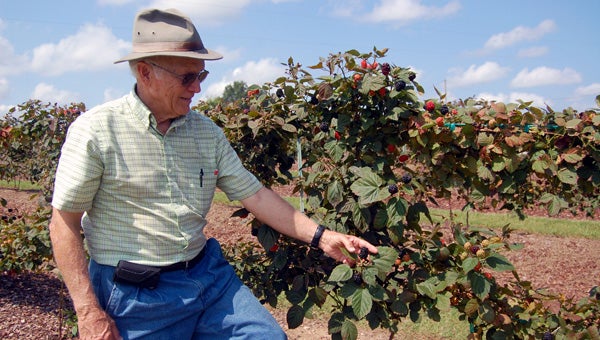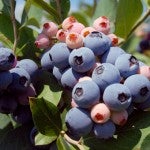
By Heather Buckner
Peach Parade, Peach Jam, Peach Queen—it would be an understatement to say that peaches are Chilton County’s claim to fame. However, while peaches are undoubtedly secure in their title as Chilton County’s prized crop, they haven’t always relished the spotlight. Blooming in the middle of peach season, there are two other fruits offering some friendly competition.
According to Dr. Arlie Powell, long-time pomologist (fruit specialist) at Petals from the Past, “Once upon a time, if you went back in Chilton County’s history—in the 1950s and 1960s—Chilton County had a substantial co-op for marketing blackberries,” he said.
Over the years, the berry industry encountered several obstacles, and peaches steadily rose to claim the top rank. Clanton peaches have since had a strong presence, but the berries that were once on top are definitely making a comeback.

“The peach is a healthy fruit,” said Powell, “but if you compare everything, these berries rank very high in nutrition. Not only do they make good desserts—cobblers, ice creams—they are good for you.”
You can even see how healthy the berries are. Powell explains, “The anthocyanin pigment that creates the purple color in fruit, such as blackberries and blueberries, is one of the valuable antioxidants in our daily diet.”
Powell isn’t the only one who recognizes these berries’ benefits. USDA researchers found that blueberries rank first in antioxidants when compared to 40 other fruits and vegetables.
So why not grow your own? In addition to providing health benefits and lawn decoration, on a home garden level, growing blackberries and blueberries is surprisingly simple.
According to Powell, blackberries and blueberries are ideal for the average yard and gardener. He explained, “We have soils, unlike the silty soils of Ohio where they can grow immense amounts of corn per acre, that are sandy loam soils, and these fruits are beautifully adapted to that.”
Raspberries prefer colder climates, so most are grown in the northern regions of the United States, but blackberries and blueberries love the South’s extreme summer heat.
The blackberry is native to the Southeast, so of course it’s going to thrive in its natural habitat. You can walk out into the woods and find wild blackberries and blueberries.
This is where the different types of berries come from—breeders went into the wild, found the best varieties of berries and began to cross-pollinate them, creating better berries. The Premier blueberry, for example, has somewhat soft fruit to be used by the commercial industry, but it has superior flavor, is early in ripening and is,” Powell said, “an excellent selection for the home garden.”
The array of information available can be overwhelming, but Powell reminds locals that the Alabama Cooperative Extension System is a useful place for gardeners starting out. Just visit Gay West, the county extension coordinator; she has a wealth of information to assist gardeners in their various excursions.
After visiting West, Powell suggests going to a nursery (like Petals) and seeing what is available. People like Powell will not only direct potential gardeners to the best crops to grow, but will also ensure that they are well-educated and prepared to begin the process.
After the initial inquiries, gardeners can run into various difficulties, such as how to train or fertilize their plants. Powell offered his advice on using the internet: “While it is a valuable resource, it behooves a gardener to speak with people in the area. What works in Indiana may not work in Alabama. Speak with someone nearby that has some level of expertise.”

According to Powell, 50 percent of success in home gardening is choosing the right crop. If someone in the Black Belt of Alabama wants to grow blueberries, they’re going to have a difficult time because the Black Belt has alkaline soils (a very high pH).
If a soil pH is 7 or 8, it is alkaline—some call it sweet soil. If it is below 7, it is acidic. Central Clanton generally has a pH of 4.5–5.4, so it is acidic compared to the normally alkaline soils of Alabama. This makes it ideal for blueberries.
Powell said this is what makes preliminary research so invaluable—“You have to look at the soil pH, the amount of rainfall, the climate, how many chill hours you get during the winter and potential diseases.”
For example, if you grow a Thompson seedless grape, it will grow for about three years before it dies from Pierce’s Disease, while a muscadine grape is immune to that particular disease.
“If you grow certain things south of Birmingham, Pierce’s Disease is going to kill it,” Powell said. “It’s that sort of thing we are here to help you with, especially when you’re just starting out. Don’t make any more mistakes than necessary.”
Even with all of these resources at their fingertips, some will fail at their initial gardening attempts. Dr. Powell laughed and said, “Tell someone he can’t grow a raspberry, and he will go outside and plant a raspberry.”
But Powell’s advice is to start with something easy to grow, something with which you will feel successful, and these berries make an excellent starter crop.
However, success with these berries depends partly on preliminary research; one of the first things a gardener should do is determine the acidity of the soil using a soil-sampling box, available at any local co-op extension center.
It’s a simple process, according to Powell. Take soil samples across the garden area, after a pint or two, stir the soil with a nonmetal object, transfer it to the soil sample box and ship it to Auburn or any other commercial lab.
They, in turn, will send back results. Those interested can even pay online and have their results emailed to them within days.
West agreed: “You can actually end up spending a lot of money on things you don’t need, trying to nourish the soil in ways it doesn’t need. So I would recommend that you go ahead and pay $7 for a soil test. It saves time and money in the long run.”
After testing, Powell suggests preparing for new crops in different ways, such as building a small trellis for blackberry plants.
As easy as growing blackberries can be, for newbies looking to plant their own edible landscape, blueberries are the best place to start. They are the lowest maintenance; a trellis is not necessary, the plants require fewer pesticides than most and the fruits are easy to harvest.
For a family of four, six plants are plenty—each plant can produce anywhere from 8 to 15 pounds. Powell has countless tips for the little obstacles gardeners face, such as using pine bark to control weeds and moisture, post-harvest fertilizing and pruning to reduce height—this will improve the plant’s health and increase future production.
“A heavy crop stresses a plant just like work stresses a person,” Powell said. Getting crops prepared for winter will help the plant yield more fruit the next year.
With peach season in full swing, Powell has an alternative for the home gardener—berries that are healthy to eat, look great in a garden and are “a snap” to grow.
Powell puts it this way: “Everyone knows Chilton County for our peaches, but we have a lot more to offer.”
